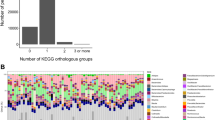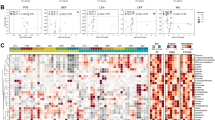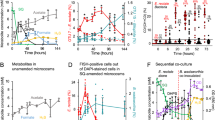Abstract
Dietary habits have been associated with alterations of the human gut resident microorganisms contributing to obesity, diabetes and cancer1. In Western diets, red meat is a frequently eaten food2, but long-term consumption has been associated with increased risk of disease3,4. Red meat is enriched in N-glycolylneuraminic acid (Neu5Gc) that cannot be synthesized by humans5. However, consumption can cause Neu5Gc incorporation into cell surface glycans6, especially in carcinomas4,7. As a consequence, an inflammatory response is triggered when Neu5Gc-containing glycans encounter circulating anti-Neu5Gc antibodies8,9. Although bacteria can use free sialic acids as a nutrient source10,11,12, it is currently unknown if gut microorganisms contribute to releasing Neu5Gc from food. We found that a Neu5Gc-rich diet induces changes in the gut microbiota, with Bacteroidales and Clostridiales responding the most. Genome assembling of mouse and human shotgun metagenomic sequencing identified bacterial sialidases with previously unobserved substrate preference for Neu5Gc-containing glycans. X-ray crystallography revealed key amino acids potentially contributing to substrate preference. Additionally, we verified that mouse and human sialidases were able to release Neu5Gc from red meat. The release of Neu5Gc from red meat using bacterial sialidases could reduce the risk of inflammatory diseases associated with red meat consumption, including colorectal cancer4 and atherosclerosis13.
This is a preview of subscription content, access via your institution
Access options
Access Nature and 54 other Nature Portfolio journals
Get Nature+, our best-value online-access subscription
$29.99 / 30 days
cancel any time
Subscribe to this journal
Receive 12 digital issues and online access to articles
$119.00 per year
only $9.92 per issue
Buy this article
- Purchase on Springer Link
- Instant access to full article PDF
Prices may be subject to local taxes which are calculated during checkout



Similar content being viewed by others
Data availability
Sequencing data supporting the findings of this study are available under accession number PRJNA505660. X-ray crystallographic data that support the findings of this study have been deposited in the RCSB (Research Collaboratory for Structural Bioinformatics) Protein Data Bank (accession codes: 6MRX, 6MRV, 6MYV and 6MNJ).
Code availability
The code used to generate the figures and for statistical analysis can be accessed from the corresponding author upon request.
References
Hall, A. B., Tolonen, A. C. & Xavier, R. J. Human genetic variation and the gut microbiome in disease. Nat. Rev. Genet. 18, 690–699 (2017).
Mann, N. Dietary lean red meat and human evolution. Eur. J. Nutr. 39, 71–79 (2000).
Etemadi, A. et al. Mortality from different causes associated with meat, heme iron, nitrates, and nitrites in the NIH-AARP Diet and Health Study: population based cohort study. BMJ 357, 1–11 (2017).
Alisson-Silva, F., Kawanishi, K. & Varki, A. Human risk of diseases associated with red meat intake: analysis of current theories and proposed role for metabolic incorporation of a non-human sialic acid. Mol. Aspects Med. 51, 16–30 (2016).
Samraj, A. N. et al. A red meat-derived glycan promotes inflammation and cancer progression. Proc. Natl Acad. Sci. USA 112, 542–547 (2015).
Tangvoranuntakul, P. et al. Human uptake and incorporation of an immunogenic non-human dietary sialic acid. Proc. Natl Acad. Sci. USA 100, 12045–12050 (2003).
Samraj, A. N., Laubli, H., Varki, N. & Varki, A. Involvement of a non-human sialic acid in human cancer. Front. Oncol. 4, 1–13 (2014).
Varki, A. Uniquely human evolution of sialic acid genetics and biology. Proc. Natl Acad. Sci. USA 107, 8939–8946 (2010).
Dhar, C., Sasmal, A. & Varki, A. From ‘serum sickness’ to ‘xenosialitis’: past, present, and future significance of the non-human sialic acid Neu5Gc. Front. Immunol. 10, 807 (2019).
Almagro-Moreno, S. & Boyd, E. F. Sialic acid catabolism confers a competitive advantage to pathogenic Vibrio cholerae in the mouse intestine. Infect. Immun. 77, 3807–3816 (2009).
McDonald, N. D., Lubin, J.-B., Chowdhury, N. & Boyd, E. F. Host-derived sialic acids are an important nutrient source required for optimal bacterial fitness in vivo. MBio 7, e02237–15 (2016).
Lewis, A. L. & Lewis, W. G. Host sialoglycans and bacterial sialidases: a mucosal perspective. Cell. Microbiol. 14, 1174–1182 (2012).
Kawanishi, K. et al. Human species-specific loss of CMP-N-acetylneuraminic acid hydroxylase enhances atherosclerosis via intrinsic and extrinsic mechanisms. Proc. Natl Acad. Sci. USA 116, 16036–16045 (2019).
Banda, K., Gregg, C. J., Chow, R., Varki, N. M. & Varki, A. Metabolism of vertebrate amino sugars with N-glycolyl groups: mechanisms underlying gastrointestinal incorporation of the non-human sialic acid xeno-autoantigen N-glycolylneuraminic acid. J. Biol. Chem. 287, 28852–28864 (2012).
Almagro-Moreno, S. & Boyd, E. F. Insights into the evolution of sialic acid catabolism among bacteria. BMC Evol. Biol. 9, 118 (2009).
Almagro-Moreno, S. & Boyd, E. F. Bacterial catabolism of non-ulosonic (sialic) acid and fitness in the gut. Gut Microbes 1, 45–50 (2010).
Li, J. & McClane, B. A. NanI sialidase can support the growth and survival of Clostridium perfringens strain F4969 in the presence of sialyated host macromolecules (mucin) or Caco-2 cells. Infect. Immun. 86, e00547–17 (2018).
Tailford, L. E. et al. Discovery of intramolecular trans-sialidases in human gut microbiota suggests novel mechanisms of mucosal adaptation. Nat. Commun. 6, 7624 (2015).
Kim, S., Oh, D. B., Kang, H. A. & Kwon, O. Features and applications of bacterial sialidases. Appl. Microbiol. Biotechnol. 91, 1–15 (2011).
Juge, N., Tailford, L. & Owen, C. D. Sialidases from gut bacteria: a mini-review. Biochem. Soc. Trans. 44, 166–175 (2016).
Chokhawala, H. A., Yu, H. & Chen, X. High-throughput substrate specificity studies of sialidases by using chemoenzymatically synthesized sialoside libraries. Chembiochem 8, 194–201 (2007).
Huang, Y. L., Chassard, C., Hausmann, M., Von Itzstein, M. & Hennet, T. Sialic acid catabolism drives intestinal inflammation and microbial dysbiosis in mice. Nat. Commun. 6, 8141 (2015).
Hedlund, M. et al. N-glycolylneuraminic acid deficiency in mice: implications for human biology and evolution. Mol. Cell. Biol. 27, 4340–4346 (2007).
David, L. A. et al. Diet rapidly and reproducibly alters the human gut microbiome. Nature 505, 559–563 (2014).
Flint, H. J., Scott, K. P., Duncan, S. H., Louis, P. & Forano, E. Microbial degradation of complex carbohydrates in the gut. Gut Microbes 3, 289–306 (2012).
Magnúsdóttir, S. et al. Generation of genome-scale metabolic reconstructions for 773 members of the human gut microbiota. Nat. Biotechnol. 35, 81–89 (2017).
Huang, L. et al. DbCAN-seq: a database of carbohydrate-active enzyme (CAZyme) sequence and annotation. Nucleic Acids Res. 46, D516–D521 (2018).
Owen, C. D. et al. Unravelling the specificity and mechanism of sialic acid recognition by the gut symbiont Ruminococcus gnavus. Nat. Commun. 8, 2196 (2017).
Inoue, S. et al. A unique sialidase that cleaves the Neu5Gcα2→5-OglycolylNeu5Gc linkage: comparison of its specificity with that of three microbial sialidases toward four sialic acid dimers. Biochem. Biophys. Res. Commun. 280, 104–109 (2001).
Davies, L. R. L. et al. Metabolism of vertebrate amino sugars with N-glycolyl groups: resistance of α2-8-linked N-glycolylneuraminic acid to enzymatic cleavage. J. Biol. Chem. 287, 28917–28931 (2012).
Smits, S. A. et al. Seasonal cycling in the gut microbiome of the Hadza hunter–gatherers of Tanzania. Science 357, 802–805 (2017).
Schnorr, S. L. et al. Gut microbiome of the Hadza hunter–gatherers. Nat. Commun. 5, 3654 (2014).
Wood, P. L., Khan, M. A. & Moskal, J. R. Neurochemical analysis of amino acids, polyamines and carboxylic acids: GC–MS quantitation of tBDMS derivatives using ammonia positive chemical ionization. J. Chromatogr. B 831, 313–319 (2006).
Bolger, A. M., Lohse, M. & Usadel, B. Trimmomatic: a flexible trimmer for Illumina sequence data. Bioinformatics 30, 2114–2120 (2014).
Edgar, R. C. Search and clustering orders of magnitude faster than BLAST. Bioinformatics 26, 2460–2461 (2010).
Langmead, B. & Salzberg, S. L. Fast gapped-read alignment with Bowtie 2. Nat. Methods 9, 357–359 (2012).
Magoč, T. & Salzberg, S. L. FLASH: fast length adjustment of short reads to improve genome assemblies. Bioinformatics 27, 2957–2963 (2011).
Nurk, S., Meleshko, D., Korobeynikov, A. & Pevzner, P. A. MetaSPAdes: a new versatile metagenomic assembler. Genome Res. 27, 824–834 (2017).
Kang, D. D., Froula, J., Egan, R. & Wang, Z. MetaBAT, an efficient tool for accurately reconstructing single genomes from complex microbial communities. PeerJ 3, e1165 (2015).
Parks, D. H., Imelfort, M., Skennerton, C. T., Hugenholtz, P. & Tyson, G. W. CheckM: assessing the quality of microbial genomes recovered from isolates, single cells and metagenomes. Genome Res. 25, 1043–1055 (2015).
Aziz, R. K. et al. The RAST Server: rapid annotations using subsystems technology. BMC Genom. 9, 75 (2008).
Li, Y. et al. Identifying selective inhibitors against the human cytosolic sialidase NEU2 by substrate specificity studies. Mol. Biosyst. 7, 1060–1072 (2011).
Bill Cai, T., Lu, D., Landerholm, M. & Wang, P. G. Sialated diazeniumdiolate: a new sialidase-activated nitric oxide donor. Org. Lett. 6, 4203–4205 (2004).
Ercégovic, T. & Magnusson, G. Highly stereoselective α-sialylation. Synthesis of GM3-saccharide and a bis-sialic acid unit. J. Org. Chem. 60, 3378–3384 (1995).
Numata, M., Sugimoto, M., Shibayama, S. & Ogawa, T. A total synthesis of hematoside, α-NeuGc-(2→3)-β-Gal-(1→4)-β-Glc-(1→1)-Cer. Carbohydr. Res. 174, 73–85 (1988).
Battye, T. G. G., Kontogiannis, L., Johnson, O., Powell, H. R. & Leslie, A. G. W. iMOSFLM: a new graphical interface for diffraction-image processing with MOSFLM. Acta Crystallogr. D 67, 271–281 (2011).
Evans, P. Scaling and assessment of data quality. Acta Crystallogr. D. 62, 72–82 (2006).
Winn, M. D. et al. Overview of the CCP4 suite and current developments. Acta Crystallogr. D. 67, 235–242 (2011).
Kabsch, W. XDS. Acta Crystallogr. D. 66, 125–132 (2010).
Adams, P. D. et al. PHENIX: a comprehensive Python-based system for macromolecular structure solution. Acta Crystallogr. D 66, 213–221 (2010).
Emsley, P., Lohkamp, B., Scott, W. G. & Cowtan, K. Features and development of Coot. Acta Crystallogr. D 66, 486–501 (2010).
Moriarty, N. W., Grosse-Kunstleve, R. W. & Adams, P. D. Electronic ligand builder and optimization workbench (eLBOW): a tool for ligand coordinate and restraint generation. Acta Crystallogr. D 65, 1074–1080 (2009).
Tan, J., Zuniga, C. & Zengler, K. Unraveling interactions in microbial communities—from co-cultures to microbiomes. J. Microbiol. 53, 295–305 (2015).
Zengler, K. & Zaramela, L. S. The social network of microorganisms—how auxotrophies shape complex communities. Nat. Rev. Microbiol. 16, 383–390 (2018).
Zuñiga, C., Zaramela, L. & Zengler, K. Elucidation of complexity and prediction of interactions in microbial communities. Microb. Biotechnol. 10, 1500–1522 (2017).
Schellenberger, J. et al. Quantitative prediction of cellular metabolism with constraint-based models: the COBRA Toolbox v2.0. Nat. Protoc. 6, 1290–1307 (2011).
Acknowledgements
We thank all Zengler-, Varki- and Chang-lab members for helpful discussions. Research was supported in part by the National Institutes of Health under award no.R01GM32373 (to A.V.) and by the National Science Foundation under award no. IOS-1444435 (to G.C.). C.M. was supported by grants from the National Institutes of Health, USA (NIH grant no. T32GM8806) and by a Chancellor’s Research Excellence Scholarship (UCSD). F.A.-S. was partly supported by the Program Science Without Borders Bex 9254-13-7-Capes Brazil.
Author information
Authors and Affiliations
Contributions
L.S.Z., C.M., F.A.-S., A.V. and K.Z. conceptualized the study. L.S.Z., F.A.-S. and K.Z. wrote the manuscript with input from all authors. L.S.Z. and C.M. performed and analysed the microbiome experiments. L.S.Z. and S.L.D. performed the enzymatic characterization. L.S.Z., F.A.-S. and P.S. performed the animal work. S.D.R. performed the protein expression and crystallization experiments, assisted by J.H. and D.S. C.Z. performed the metabolic model analysis. L.C., M.B.G. and C.H.T. constructed the fosmid library and performed the compost sialidase activity assays. C.H.T., G.C., A.V. and K.Z. provided resources and supervised the study.
Corresponding author
Ethics declarations
Competing interests
L.S.Z., C.M., F.A.-S., S.R., S.L.D., G.C., A.V. and K.Z. have filed a patent application (number pending) that claims the use of sialidases to reduce Neu5Gc.
Additional information
Publisher’s note Springer Nature remains neutral with regard to jurisdictional claims in published maps and institutional affiliations.
Supplementary information
Supplementary Information
Supplementary Data, Discussion, Figs. 1–16, Tables 1–5 and References.
Rights and permissions
About this article
Cite this article
Zaramela, L.S., Martino, C., Alisson-Silva, F. et al. Gut bacteria responding to dietary change encode sialidases that exhibit preference for red meat-associated carbohydrates. Nat Microbiol 4, 2082–2089 (2019). https://doi.org/10.1038/s41564-019-0564-9
Received:
Accepted:
Published:
Issue Date:
DOI: https://doi.org/10.1038/s41564-019-0564-9
This article is cited by
-
Prevotella species in the human gut is primarily comprised of Prevotella copri, Prevotella stercorea and related lineages
Scientific Reports (2022)
-
Dietary regulation in health and disease
Signal Transduction and Targeted Therapy (2022)
-
Microbiota succession throughout life from the cradle to the grave
Nature Reviews Microbiology (2022)
-
Carbohydrate-active enzymes (CAZymes) in the gut microbiome
Nature Reviews Microbiology (2022)
-
Metabolic fate of dietary sialic acid and its influence on gut and oral bacteria
Systems Microbiology and Biomanufacturing (2022)



